astronauts

 In the Black Hills of South Dakota, south-west of Rapid City lies a natural depression in the Earth. Apparently, the depression is a sinkhole that has 700 feet deep cliff walls all around, that prevent wind from reaching the bottom. The windless part of the site is what makes it perfect for balloon launches. The site was noticed by the National Geographic Society and the United States Army Air Corps, who set up what they called Stratocamp in 1934-1935. Stratocamp was a joint effort code named Explorer to launch two manned giant helium high-altitude balloons capable of stratospheric flight. The crash of the Soviet Osoaviakhim-1 after setting a world record flight of 72,178 feet (13.71 miles), the Explorer program set a new goal…to beat that record. The first Explorer balloon was launched on July 28, 1934. The balloon made it 11 miles up before it disintegrated. Thankfully the astronauts onboard had parachutes on, so they survived.
In the Black Hills of South Dakota, south-west of Rapid City lies a natural depression in the Earth. Apparently, the depression is a sinkhole that has 700 feet deep cliff walls all around, that prevent wind from reaching the bottom. The windless part of the site is what makes it perfect for balloon launches. The site was noticed by the National Geographic Society and the United States Army Air Corps, who set up what they called Stratocamp in 1934-1935. Stratocamp was a joint effort code named Explorer to launch two manned giant helium high-altitude balloons capable of stratospheric flight. The crash of the Soviet Osoaviakhim-1 after setting a world record flight of 72,178 feet (13.71 miles), the Explorer program set a new goal…to beat that record. The first Explorer balloon was launched on July 28, 1934. The balloon made it 11 miles up before it disintegrated. Thankfully the astronauts onboard had parachutes on, so they survived.
The second balloon was launched in November 11, 1935, and ascended 14 miles up, before landing near White Lake, South Dakota. They had done it. That second flight set a world record that would not be broken until astronauts started flying into space. Astronauts, Air Corps Captain Albert William Stevens, Captain Arson Anderson, and Major William E. Kepner became the first men to view the Earth’s curvature. This exploration helped the Air Force build better planes and helped scientists build satellites.
In the 1950s, Project Manhigh and Project Strato-Lab launches were made from a man-made crater of an iron mining pit near Crosby, Minnesota, and if weather allowed, from Fleming Field in South Saint Paul, Minnesota. The Stratobowl was used as a backup location, if launches could not be made at the Minnesota locations. As it turned out, the Stratobowl was needed for a number of launches. The first such launch was on November 8, 1956, when the Strato-Lab I gondola lifted Malcolm Ross and M L Lewis from the Stratobowl to a world altitude record for manned balloon flight of 76,000 feet. There were also three Stratobowl launches in 1958, and seven in 1959. The most publicized flight was that of Strato-Lab IV, piloted by Malcolm Ross and Charles B Moore, which lifted off from Stratobowl on November 28, 1959. The balloon reached an altitude of 81,000 feet, and landed safely in Kansas after 20 hours in the air. The purpose of the flight was to perform spectrographic analysis of the planet Venus with minimal interference from the Earth’s atmosphere.
These days, the Stratobowl is usually seen from a popular hiking trail that takes you up to the rim…which is 
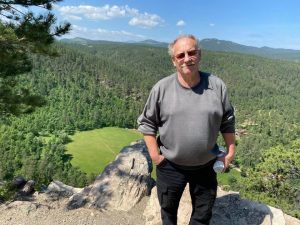 how my husband, Bob and I first saw it. You can also drive down to the bottom, and there are festivals during which balloons are launched…to go to normal heights and to take tourists and owners for a normal ride. No records are set to be won, or experiments to be made. Still, looking at the Stratobowl from the top of the trail is very impressive, and while it is not a difficult or a long hike, we enjoyed it very much, and it is a short hike that I very much recommend. It was really interesting, and to think it is a sinkhole.
how my husband, Bob and I first saw it. You can also drive down to the bottom, and there are festivals during which balloons are launched…to go to normal heights and to take tourists and owners for a normal ride. No records are set to be won, or experiments to be made. Still, looking at the Stratobowl from the top of the trail is very impressive, and while it is not a difficult or a long hike, we enjoyed it very much, and it is a short hike that I very much recommend. It was really interesting, and to think it is a sinkhole.
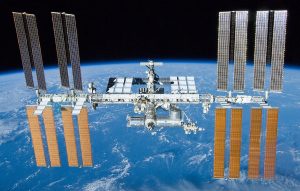 On mornings when I wake up with a backache, the idea of sleeping in a zero gravity chamber sounds appealing, but in reality, living in a zero gravity environment is probably not something I would want to do for very long. While I admit, gravity can put a strain on our bodies in many ways, I don’t think we were really designed to live our whole life without gravity. Nevertheless, living and working in space have become more commonplace than many of us realize. We don’t give much thought to the men and women who live and work in the International Space Station, or in the various crafts that have transported them there over the years.
On mornings when I wake up with a backache, the idea of sleeping in a zero gravity chamber sounds appealing, but in reality, living in a zero gravity environment is probably not something I would want to do for very long. While I admit, gravity can put a strain on our bodies in many ways, I don’t think we were really designed to live our whole life without gravity. Nevertheless, living and working in space have become more commonplace than many of us realize. We don’t give much thought to the men and women who live and work in the International Space Station, or in the various crafts that have transported them there over the years.
It was on November 2, 2000, that the first residential crew would arrive aboard the International Space Station (ISS). The arrival of Expedition 1 was the mark of the beginning of a new era of international cooperation in space and of the longest continuous human habitation in low Earth orbit…and it continues to this day…even without the Space Shuttle’s operation…though I don’t think it is as easy to work out the logistics without the Space Shuttle. Two Russians, Yuri Gidzenko and Sergei Krikalev, accompanied by NASA’s Bill Shepherd, were selected as the crew of Expedition 1.
It was decided that we needed an International Space Station in 1998, and the space agencies of the United States, Russia, Canada, Japan and Europe agreed to cooperate to bring it to pass. Its first components were launched into orbit later that year. In all, there would be five space shuttle flights and two unmanned Russian flights to complete the delivery of many of its core components and partially assemble the space station. It was 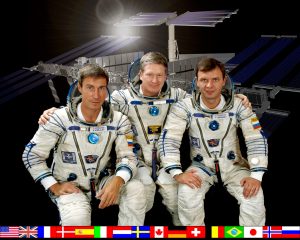 a huge project that would possibly accomplish in space, what we had never been able to accomplish on Earth…nations working together on experiments that mattered to all of them to bring about changes in key areas like health, agriculture, energy, and a host of other things. The ISS was truly a first.
a huge project that would possibly accomplish in space, what we had never been able to accomplish on Earth…nations working together on experiments that mattered to all of them to bring about changes in key areas like health, agriculture, energy, and a host of other things. The ISS was truly a first.
The two cosmonauts and the astronaut arrived at the ISS on a Russian Soyuz rocket that had been launched from Kazakhstan. This first mission was tasked mostly with constructing and installing various components and activating others. This was sometimes easier said than done, and in fact, the crew reported that it took over a day to activate one of the station’s food warmers. I hope they weren’t too hungry!! Throughout their time in space, they were visited and resupplied by two unmanned Russian rockets and three space shuttle missions, one of which brought the photovoltaic arrays, giant solar panels, which provide most of the station’s power.
Shepherd, Gidzenko and Krikalev became the first humans to adjust to long-term life in low orbit, circling the Earth roughly 15.5 times a day and exercising at least two hours a day in order to offset the muscle atrophy that occurs in low gravity. This is where I thought relief of backaches for sleeping wrong might have been solved, but it turns out that there were a host of other problems that come for long-term weightlessness. Who knew? Things like lessened bone density, and pain in joints upon returning to Earth. Hmmm, I guess I’ll sleep here on Earth in gravity, and take Excedrin as needed.
 Finally, on March 10, four months after they arrived at the ISS, the space shuttle Discovery brought three new residents to relieve Expedition 1, who landed back on Earth at the Kennedy Space Center on March 21. Since then, humans have continuously resided on the ISS, with plans to continue until at least 2030. 236 people from 18 nations have visited the station and a number of new modules have been added, many for the purpose of research into biology, material sciences, the feasibility of further human space travel and more. Some tams have been there longer than other teams, but all of them have made great contributions to science during their time on the ISS.
Finally, on March 10, four months after they arrived at the ISS, the space shuttle Discovery brought three new residents to relieve Expedition 1, who landed back on Earth at the Kennedy Space Center on March 21. Since then, humans have continuously resided on the ISS, with plans to continue until at least 2030. 236 people from 18 nations have visited the station and a number of new modules have been added, many for the purpose of research into biology, material sciences, the feasibility of further human space travel and more. Some tams have been there longer than other teams, but all of them have made great contributions to science during their time on the ISS.
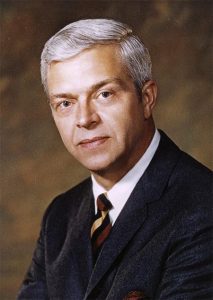 With the arrival of the 50th anniversary of the landing on the moon, on July 20, 2019, many people have been reviewing old footage and books about the event. I came across a book that caught my eye on Audible. The book, The Man Who Knew The Way To The Moon, by Todd Zwillich wasn’t exactly about the moon landing, but rather how it became possible. The book begins with Russia beating the United States to the punch when they sent a man Yuri Alekseyevich Gagarin, into space on April 12, 1961. As short as the flight was…just 89 minutes…it was still an embarrassment to the United States who felt they should have been first.
With the arrival of the 50th anniversary of the landing on the moon, on July 20, 2019, many people have been reviewing old footage and books about the event. I came across a book that caught my eye on Audible. The book, The Man Who Knew The Way To The Moon, by Todd Zwillich wasn’t exactly about the moon landing, but rather how it became possible. The book begins with Russia beating the United States to the punch when they sent a man Yuri Alekseyevich Gagarin, into space on April 12, 1961. As short as the flight was…just 89 minutes…it was still an embarrassment to the United States who felt they should have been first.
In answer to the Soviet space flight, President Kennedy challenged NASA to put a man on the moon before the end of the decade. NASA sort of panicked. Yes, they had been thinking about a moon landing…and some remote point down the road, but they were nowhere near ready to go them by the end of the decade. Nevertheless, they began to explore ideas to make it happen. One of those people who had been considering a way to make the landing possible. By this time, no one doubted the ability to go into space, and to safely return to earth. Landing on the moon was a different story.
The widely accepted method of landing on the moon was to have the original rocket back onto the moon, carrying enough fuel to take off again and return to Earth. A man named John Houbolt thought that was…well, simply impossible. Now, I’m no aeronautical engineer, like Houbolt was, and maybe I have the advantage of  knowing about the past space exploration victories, but when I think about three astronauts backing a 90 foot high, fully fueled rocket onto the moon…all I can say is, “That’s ludicrous!!” People often say that an idea doesn’t take a rocket scientist, and it this case, maybe it shouldn’t be a rocket scientist, but rather an aeronautical engineer.
knowing about the past space exploration victories, but when I think about three astronauts backing a 90 foot high, fully fueled rocket onto the moon…all I can say is, “That’s ludicrous!!” People often say that an idea doesn’t take a rocket scientist, and it this case, maybe it shouldn’t be a rocket scientist, but rather an aeronautical engineer.
John Houbolt, kept saying and trying to be heard, that it wouldn’t work, but he had a plan that would…Lunar Orbit Rendezvous or LOR. In Houbolt’s design, a smaller lunar module would land on the moon while the command module waited above. Then the Lunar module would take of and dock with the command module for the trip back to Earth. It is the way we know did work, because we have the advantage of time, but the scientists and engineers at NASA would not listen. One man, Max Faget, an immigrant from British Honduras, who designed the Mercury module, actually stood up at a meeting where Houbolt was presenting his idea, and yelled at the group, saying, “His figures lie! He doesn’t know what he’s talking about!” Houbolt was horribly humiliated, and he never forgot the incident. He didn’t let it stop him either. In the end, as Faget spent many hours trying desperately to make his own figures work, so 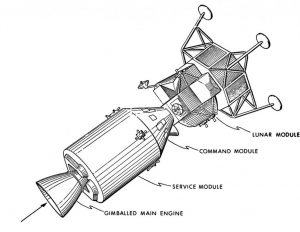 that a rocket could back onto the moon, he finally had to admit defeat. He called John Houbolt, and conceded the lunar landing design to Houbolt’s design, which was, as we all know, completely successful, because after all, his figures did not lie, and he did know what he was talking about. It was a great moment in history, and in Houbolt’s life, except for the fact that no one knew that the successful landing was his design. While the Lunar landing, 50 years ago was an amazing accomplishment, I find it quite sad that it took so many years for the world to know about how one man’s refusal to give up, actually made Lunar landing possible. We owe John Houbolt a great debt of gratitude, and it is more than 50 years overdue. Now that’s ludicrous!!
that a rocket could back onto the moon, he finally had to admit defeat. He called John Houbolt, and conceded the lunar landing design to Houbolt’s design, which was, as we all know, completely successful, because after all, his figures did not lie, and he did know what he was talking about. It was a great moment in history, and in Houbolt’s life, except for the fact that no one knew that the successful landing was his design. While the Lunar landing, 50 years ago was an amazing accomplishment, I find it quite sad that it took so many years for the world to know about how one man’s refusal to give up, actually made Lunar landing possible. We owe John Houbolt a great debt of gratitude, and it is more than 50 years overdue. Now that’s ludicrous!!
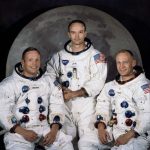 When the Apollo 11 crew landed on the moon, the world waited with unbridled excitement to view the moon rocks they were bringing back. It was an unprecedented event. Never before had man been able to look upon these space rocks. Soon, the astronauts would be treated to a ticker tape parades, and of course, the world tour to tell of their amazing escapades.
When the Apollo 11 crew landed on the moon, the world waited with unbridled excitement to view the moon rocks they were bringing back. It was an unprecedented event. Never before had man been able to look upon these space rocks. Soon, the astronauts would be treated to a ticker tape parades, and of course, the world tour to tell of their amazing escapades.
However, before all that, the astronauts had to do something that every world traveler understands…go through customs. What??? When I read that, I was stunned. Why would they need to go through customs? It’s not like they went shopping on the moon. Then again, they did bring back something they didn’t take with them…moon rocks, moon dust and other lunar samples, according to the customs form filed at the Honolulu Airport in Hawaii on July 24, 1969…the day the Apollo 11 screw splashed down in the Pacific Ocean to end their historic moon landing mission. Nevertheless, NASA had those almost immediately, didn’t they?
Apollo 11 astronauts Neil Armstrong, Buzz Aldrin and Michael Collins hd to declare the things they brought back, just like everyone else, and they had to declare not only their cargo, but also had to list their flight route as starting Cape Kennedy (now Cape Canaveral) in Florida with a stopover on the moon. Then all three men had to sign the form, so everything was legal.
The form was posted to the U.S. Customs and Border Protection Web site in 2009, to mark the Apollo 11 mission’s 40th anniversary. A copy was obtained by SPACE.com and verified by NASA. John Yembrick told SPACE.com that it was indeed authentic, was a little joke at that time, and maybe it was, but the reality is that not much has changed over the years. The big joke was the fact that because Apollo 11 splashed down 920 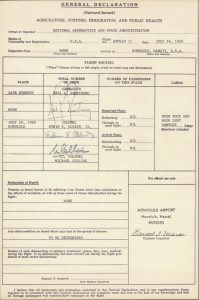 miles southwest of Hawaii and 13 miles from the USS Hornet, the Navy ship sent to recover the crew. It took two more days for the astronauts to actually return to Hawaii on July 26, where they were welcomed with a July 27 ceremony at Pearl Harbor. So customs was a bit delayed.
miles southwest of Hawaii and 13 miles from the USS Hornet, the Navy ship sent to recover the crew. It took two more days for the astronauts to actually return to Hawaii on July 26, where they were welcomed with a July 27 ceremony at Pearl Harbor. So customs was a bit delayed.
Still, the astronauts were trapped inside a NASA trailer as part of a quarantine effort. The concern was the possibility of germs they might have picked up. They had to wear special biological containment suits when they walked out on the deck of the USS Hornet after being retrieved. Then, NASA transported them to Houston, quarantine trailer and all, and they emerged from isolation three weeks later. Today’s returning astronauts exit their spacecraft almost immediately. Some, who have been in space a long time receive medical checks after spending months in the weightlessness of space. Nevertheless, today’s NASA astronauts still have to go through customs, and I still find that quite funny.
 Most people know that at 10:56pm EDT, on July 20, 1969, American astronaut Neil Armstrong, 240,000 miles from Earth, speaks these words to more than a billion people listening at home, “That’s one small step for man, one giant leap for mankind.” Stepping off the lunar landing module Eagle, Armstrong became the first human to walk on the surface of the moon. The moment was historic, in more ways than one. Yes, the United States was the first nation to put a man on the moon. John F Kennedy’s dream had become a reality. On May 25, 1961, Kennedy made his famous appeal to a special joint session of Congress: “I believe this nation should commit itself to achieving the goal, before this decade is out, of landing a man on the moon and returning him safely to Earth.”
Most people know that at 10:56pm EDT, on July 20, 1969, American astronaut Neil Armstrong, 240,000 miles from Earth, speaks these words to more than a billion people listening at home, “That’s one small step for man, one giant leap for mankind.” Stepping off the lunar landing module Eagle, Armstrong became the first human to walk on the surface of the moon. The moment was historic, in more ways than one. Yes, the United States was the first nation to put a man on the moon. John F Kennedy’s dream had become a reality. On May 25, 1961, Kennedy made his famous appeal to a special joint session of Congress: “I believe this nation should commit itself to achieving the goal, before this decade is out, of landing a man on the moon and returning him safely to Earth.”
Most people know the rest of the story, or do they. At that moment, and for the next few moments, Neil Armstrong was the only human to step foot on the moon. He would always be the first human to step foot on the moon, but for a few minutes, he was the only human to do so. “Buzz” Aldrin joined him on the moon’s surface at 11:11pm, so now there were two humans who had walked on the moon, and while that was quite different from Armstrong’s feeling of being the only human to walk on the moon, it was still something so unique that I’m sure it had to be almost mind-boggling. Lots of us have done something that no one else in our  family or social circle has done, and the feeling of accomplishment is almost like a high, but this was something that no other human had ever done. Now that’s a high!! Of course, Armstrong wasn’t the only human to ever experience something like that. Many pioneers in different areas of history did the same thing. The first flight, the first car, the first heart transplant…the list goes on, but all of those had one thing in common. They were done on Earth. Armstrong was the first person to walk on a planet that was not the Earth. No matter how you look at it, this was unique, and Armstrong stood alone among human beings…not only for his accomplishment, but more for where it took place.
family or social circle has done, and the feeling of accomplishment is almost like a high, but this was something that no other human had ever done. Now that’s a high!! Of course, Armstrong wasn’t the only human to ever experience something like that. Many pioneers in different areas of history did the same thing. The first flight, the first car, the first heart transplant…the list goes on, but all of those had one thing in common. They were done on Earth. Armstrong was the first person to walk on a planet that was not the Earth. No matter how you look at it, this was unique, and Armstrong stood alone among human beings…not only for his accomplishment, but more for where it took place.
After “Buzz” Aldrin joined Neil Armstrong on the moon’s surface, they took photographs of the terrain, planted a United States flag on its surface. Then they ran a few simple scientific tests, and spoke with President Richard M Nixon via Houston. By 1:11am on July 21, both astronauts were back in the lunar module and the hatch was closed. The two men slept that night on the surface of the moon. Then, at 1:54pm the Eagle began its ascent back to the command module. Among the items left on the surface of the moon was a plaque that read: “Here men from the planet Earth first set foot on the moon–July 1969 A.D–We came in peace for all mankind.” There would be five more successful lunar landing missions, and one unplanned lunar swing-by, when Apollo 13 experienced a malfunction that nearly made it impossible to return to Earth. The last men to walk on the moon, astronauts Eugene Cernan and Harrison Schmitt of the Apollo 17 mission, left the lunar surface on December  14, 1972. In all, 12 men walked on the moon. All Americans, they were, on Apollo 11: Neil Armstrong (NASA Civilian) and Buzz Aldrin (USAF), on Apollo 12: Pete Conrad (US Navy) and Alan Bean (US Navy), on Apollo 14: Alan Shepard (US Navy) and Edgar Mitchell (US Navy), on Apollo 15: David Scott (USAF) and James Irwin (USAF), on Apollo 16: John Young (US Navy) and Charles Duke (USAF), and on Apollo 17: Gene Cernan (US Navy) and Harrison Schmitt (NASA Civilian). While Neil Armstrong was the only human to walk on the moon’s surface for 15 minutes in time, there were 11 others who had the distinct honor of walking on the moon, and while they weren’t the only humans, they were the only 12 humans to do so, and that had to feel really strange to them for the rest of their lives.
14, 1972. In all, 12 men walked on the moon. All Americans, they were, on Apollo 11: Neil Armstrong (NASA Civilian) and Buzz Aldrin (USAF), on Apollo 12: Pete Conrad (US Navy) and Alan Bean (US Navy), on Apollo 14: Alan Shepard (US Navy) and Edgar Mitchell (US Navy), on Apollo 15: David Scott (USAF) and James Irwin (USAF), on Apollo 16: John Young (US Navy) and Charles Duke (USAF), and on Apollo 17: Gene Cernan (US Navy) and Harrison Schmitt (NASA Civilian). While Neil Armstrong was the only human to walk on the moon’s surface for 15 minutes in time, there were 11 others who had the distinct honor of walking on the moon, and while they weren’t the only humans, they were the only 12 humans to do so, and that had to feel really strange to them for the rest of their lives.
 The year was 1959, and things were changing rapidly in the world of flight. Airplanes had been around, and actually flying since the December 17, 1903 flight of the Kitty Hawk by the Wright brothers. Air travel, while not as common as it is today, was fairly common. Now, it was time for the next step. We had looked through telescopes, found the planets, their moons, and other suns. We discovered galaxies beyond our own, and then, someone…somewhere, decided that it was time for mankind to go out there and have a look for ourselves.
The year was 1959, and things were changing rapidly in the world of flight. Airplanes had been around, and actually flying since the December 17, 1903 flight of the Kitty Hawk by the Wright brothers. Air travel, while not as common as it is today, was fairly common. Now, it was time for the next step. We had looked through telescopes, found the planets, their moons, and other suns. We discovered galaxies beyond our own, and then, someone…somewhere, decided that it was time for mankind to go out there and have a look for ourselves.
By late 1958 plans were well underway to take that first step. Seven men were picked, and on this day April 9, 1959 NASA announced that they had decided on the first seven astronauts, who would take that very first space flight. The men were dubbed The Mercury Seven, but were also called the Original Seven or Astronaut Group 1. The men were Scott Carpenter, Gordon Cooper, John Glenn, Gus Grissom, Wally Schirra, Alan Shepard, and Deke Slayton. They piloted the manned spaceflights of the Mercury program from May 1961 to May 1963. They weren’t the first men in space, but they were the first from the United States. The first human to journey into outer space, was Yuri Gagarin, when his Vostok spacecraft completed an orbit of the Earth on 12 April 1961. Alan Shepard became the first American in space 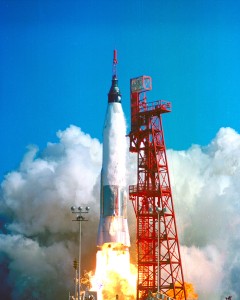 when the Freedom 7 spacecraft blasted off from Florida on May 5, 1961, just under a month after the Russian flight. Ten years later, Shepard would fly again to become the fifth man to walk on the moon…and the first to play golf there.
when the Freedom 7 spacecraft blasted off from Florida on May 5, 1961, just under a month after the Russian flight. Ten years later, Shepard would fly again to become the fifth man to walk on the moon…and the first to play golf there.
Most of these seven men went on to fly in many successful missions, with Gus Grissom being the only one to die young and on duty with NASA, in the Apollo 1 fire. Members of the group flew on all classes of NASA manned orbital spacecraft of the 20th century…Mercury, Gemini, Apollo, and the Space Shuttle. John Glenn, the oldest, is the only one who is still living. He went on to become a United States senator, and flew on the Shuttle 36 years later to become the oldest person to fly in space. The others all survived past retirement from service. These men played a key part in the world as we know it today, because space travel has played a key part in many of our modern medicines and scientific research. And it all began on this day in 1959.
 Inspiration comes from many different places, but most often from an event that so strongly affects our emotions or our lives, that we feel the need to act. That is what happened to a number of students who all had something in common…Christa McAuliffe. On this day, January 28, 1986…30 years ago, after months of training and a huge national following, Christa McAuliffe entered the Space Shuttle Challenger, and went down in history as not only the first teacher chosen to go into space, but the first civilian to die on such a mission. She never made it into space, because just 73 seconds after the launch, the Challenger exploded.
Inspiration comes from many different places, but most often from an event that so strongly affects our emotions or our lives, that we feel the need to act. That is what happened to a number of students who all had something in common…Christa McAuliffe. On this day, January 28, 1986…30 years ago, after months of training and a huge national following, Christa McAuliffe entered the Space Shuttle Challenger, and went down in history as not only the first teacher chosen to go into space, but the first civilian to die on such a mission. She never made it into space, because just 73 seconds after the launch, the Challenger exploded.
The world looked on in horror, because this launch had been so widely televised and so greatly anticipated.  After the explosion, the news was broadcast over and over. We saw the horrified faces of the families of the crew, the tears of family, friends, and students of the first teacher in space, and we saw the explosion…over and over again. The heart of a nation was broken, not just because of Christa McAuliffe, but also for the families of payload specialist Gregory Jarvis; and astronauts Judith A. Resnik, mission specialist; Francis R. (Dick) Scobee, mission commander; Ronald E. McNair, mission specialist; Mike J. Smith, pilot; and Ellison S. Onizuka, mission specialist. It had been many years since the NASA space program had lost a crew, and it was the first one in flight.
After the explosion, the news was broadcast over and over. We saw the horrified faces of the families of the crew, the tears of family, friends, and students of the first teacher in space, and we saw the explosion…over and over again. The heart of a nation was broken, not just because of Christa McAuliffe, but also for the families of payload specialist Gregory Jarvis; and astronauts Judith A. Resnik, mission specialist; Francis R. (Dick) Scobee, mission commander; Ronald E. McNair, mission specialist; Mike J. Smith, pilot; and Ellison S. Onizuka, mission specialist. It had been many years since the NASA space program had lost a crew, and it was the first one in flight.
I’m sure that an accident in space did not inspire people to go into the space program, because the safety of the program immediately came into question. Nevertheless, from this tragedy…from out of the ashes of the Space Shuttle Challenger, inspiration did come. It came in the form of teachers. The students of Christa  McAuliffe…not all, but a number of them, were inspired to become teachers themselves. Each of those former students of Christa McAuliffe…kids who maybe didn’t like social studies, but because Christa McAuliffe made it interesting somehow, they did well in her class, and were inspired by her. After her passing, these inspired students decided that they wanted to pick up where she left off. They wanted to carry on with her dream. They follow her motto, “I touch the future. I teach.” One of those teachers commented that she heard people say that and wondered if they had any idea where that motto came from. Her former students knew…it was Christa McAuliffe, and her legacy lives on, 30 years after her death.
McAuliffe…not all, but a number of them, were inspired to become teachers themselves. Each of those former students of Christa McAuliffe…kids who maybe didn’t like social studies, but because Christa McAuliffe made it interesting somehow, they did well in her class, and were inspired by her. After her passing, these inspired students decided that they wanted to pick up where she left off. They wanted to carry on with her dream. They follow her motto, “I touch the future. I teach.” One of those teachers commented that she heard people say that and wondered if they had any idea where that motto came from. Her former students knew…it was Christa McAuliffe, and her legacy lives on, 30 years after her death.
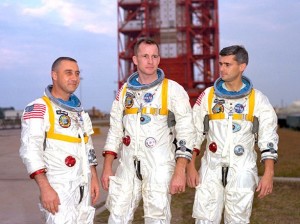
 The NASA Space Program had suffered relatively few losses during it’s many years of existence, but when something happens, it is felt around the world. Like a plane crash, it hits everyone very hard. What I find very strange is the fact that NASA’s three tragedies that brought about loss of life, while years apart, all took place within a week’s time of each other. All three of these losses were very different in how they happened. The January 27, 1967 fire on the launch pad that took the lives of Virgil “Gus” Grissom, Edward White II, Roger Chaffee in a routine ground test of the capsule that would later become Apollo 1 was a fire started by an electrical spark. The fire engulfed their high-pressurized, pure-oxygen cabin, and the astronauts suffocated. There was no emergency release on the door. They couldn’t get out. The Challenger, was lost on the 28th of January, 1986. It blew up during launch because an O-ring failed when the fuel tanks were stirred, killing all seven of the astronauts, and leaving the nation in mourning at the loss of Francis “Dick” Scobee, Ron McNair, Mike Smith, Ellison Onizuka, Judy Resnik, Greg Jarvis, and Christa McAuliffe.
The NASA Space Program had suffered relatively few losses during it’s many years of existence, but when something happens, it is felt around the world. Like a plane crash, it hits everyone very hard. What I find very strange is the fact that NASA’s three tragedies that brought about loss of life, while years apart, all took place within a week’s time of each other. All three of these losses were very different in how they happened. The January 27, 1967 fire on the launch pad that took the lives of Virgil “Gus” Grissom, Edward White II, Roger Chaffee in a routine ground test of the capsule that would later become Apollo 1 was a fire started by an electrical spark. The fire engulfed their high-pressurized, pure-oxygen cabin, and the astronauts suffocated. There was no emergency release on the door. They couldn’t get out. The Challenger, was lost on the 28th of January, 1986. It blew up during launch because an O-ring failed when the fuel tanks were stirred, killing all seven of the astronauts, and leaving the nation in mourning at the loss of Francis “Dick” Scobee, Ron McNair, Mike Smith, Ellison Onizuka, Judy Resnik, Greg Jarvis, and Christa McAuliffe.
The third NASA loss took place on February 1, 2003, and this one happened on re-entry into our atmosphere. The damage that caused the demise of the Space Shuttle Columbia happened during the launch, when a piece of foam insulation broke off and damaged the leading edge of the wing. When the shuttle re-entered the Earth’s atmosphere, the wind and heat entered the wing and blew it apart, because the heat-resistant tiles covering the left wing’s leading edge had been damaged or were missing. Pieces of the shuttle began raining down across Texas, as well as the bodies of the astronauts. This loss was very different than the others, in that is was a much less controlled situation. The prior losses could be cordoned off and kept out of the public view, but the way that Columbia was damaged, far above the Earth, causing it to rain down over such a large area, made it impossible to control, and consequently, people were coming across bodies and debris. I can’t imagine anything worse, because these were our beloved astronauts, and this was such an undignified end. It was heart wrenching for everyone in this nation. We will always remember Rick Husband, Willie McCool, Michael Anderson, Kalpana Chawla, David Brown, Laurel Clark and Israeli astronaut Ilan Ramon.
With the end of the space shuttle portion of the NASA program, the future of our nation’s work in space seems to be in question. It is hard for me to imagine going from the Space Shuttle, with the amazing ability to land like an airplane, back to a rocket. The new Orion rocket is designed to go further that any other spacecraft, and 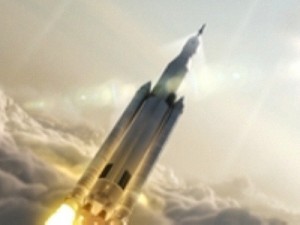
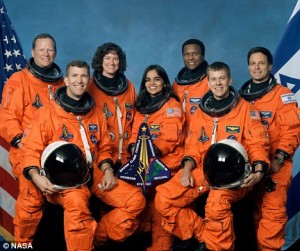 the astronauts are used to living in space for six months at a time, so the possibilities are endless, and only time will tell. With each loss come a new wisdom and increased knowledge about the things that make our astronauts unsafe, and what things can keep them safe on their journeys into the unknown. Today, however, is a day to remember NASA’s lost ones on the twelfth anniversary of the loss of the Space Shuttle Columbia.
the astronauts are used to living in space for six months at a time, so the possibilities are endless, and only time will tell. With each loss come a new wisdom and increased knowledge about the things that make our astronauts unsafe, and what things can keep them safe on their journeys into the unknown. Today, however, is a day to remember NASA’s lost ones on the twelfth anniversary of the loss of the Space Shuttle Columbia.
 Every time disaster strikes, it seems like we always remember where we were and what we were doing the moment we found out about it. Moments like September 11, 2001, the Kennedy assassinations, Reagan’s shooting, and for me, the Space Shuttle Challenger explosion, are permanently imprinted on my mind. It had been so well televised. It was to be the first time an American civilian was going into space, and she was a teacher. It was an exciting event for America, and especially for the schools and the school children, who felt like they were suddenly center stage within the space program. The nation watched as the Teacher in Space candidates went through the paces to decide which teacher would be chosen. Finally the decision was made, and out of all the candidates, a woman, Christa McAuliffe stood alone as the chosen one. It was exciting for her, the school where she taught, and her family. It was excitement mixed with anxiousness, because there was always that element of danger, that you know is possible, but you never really believe would come to pass…until it does.
Every time disaster strikes, it seems like we always remember where we were and what we were doing the moment we found out about it. Moments like September 11, 2001, the Kennedy assassinations, Reagan’s shooting, and for me, the Space Shuttle Challenger explosion, are permanently imprinted on my mind. It had been so well televised. It was to be the first time an American civilian was going into space, and she was a teacher. It was an exciting event for America, and especially for the schools and the school children, who felt like they were suddenly center stage within the space program. The nation watched as the Teacher in Space candidates went through the paces to decide which teacher would be chosen. Finally the decision was made, and out of all the candidates, a woman, Christa McAuliffe stood alone as the chosen one. It was exciting for her, the school where she taught, and her family. It was excitement mixed with anxiousness, because there was always that element of danger, that you know is possible, but you never really believe would come to pass…until it does.
I was disappointed that I had to bowl on the morning that had been chosen for the launch of the Challenger. I had hoped that I could catch some of it on the television set the bowling alley had. As secretary of the league, I  had duties to perform when I got there, but I was immediately approached by one of the bowlers, who said, “Did you hear that the space shuttle exploded?” It was so unthinkable, that my mind first thought that it exploded before anyone was in it, but deep down, I knew that this was a huge disaster. I prayed that some of them would live through it, while knowing in my heart, that they could not have lived through it. It was hard to bowl that day, but there was nothing else we could do. The televisions were on, and we watched as the explosion was played over and over again. Then we went home, and watched more of it at home. Sometimes, I think that people have a tendency to think that if they watch a disaster over and over, that maybe somehow it will have a different outcome…as irrational as that sounds.
had duties to perform when I got there, but I was immediately approached by one of the bowlers, who said, “Did you hear that the space shuttle exploded?” It was so unthinkable, that my mind first thought that it exploded before anyone was in it, but deep down, I knew that this was a huge disaster. I prayed that some of them would live through it, while knowing in my heart, that they could not have lived through it. It was hard to bowl that day, but there was nothing else we could do. The televisions were on, and we watched as the explosion was played over and over again. Then we went home, and watched more of it at home. Sometimes, I think that people have a tendency to think that if they watch a disaster over and over, that maybe somehow it will have a different outcome…as irrational as that sounds.
This whole disaster gave me a different view of the space shuttle, and so when we had the opportunity to visit the Johnson Space Center in Houston, Texas, I found the view of the space shuttle, and all it’s inner workings to be the most interesting. Standing inside the shuttle display, I felt a mixture of excitement and a little dread. It wasn’t that I was concerned for me, but rather that the Challenger’s lost astronauts came back to my mind. I felt a tiny bit of their excitement, and yet I knew that they would never get to fully live their dream, but would die  tragically just 73 second into the flight. Just a little over a minute into their dream. So close, and yet so suddenly it was over…forever. There would be no second chance for them, and this event would bring a lasting emptiness to their families. Events like these scar the people of nation. We may not think of them every day, but when we are reminded of them, such as today, on the 29th anniversary of the event, we can’t help but to be taken back to the day of the event. We can vividly picture each and every second of it, knowing that the loss of life is enormous…knowing that not only are those who died, gone from their families now, but the families are left to pick up the pieces. And we are left remembering exactly where we were when we heard the tragic news.
tragically just 73 second into the flight. Just a little over a minute into their dream. So close, and yet so suddenly it was over…forever. There would be no second chance for them, and this event would bring a lasting emptiness to their families. Events like these scar the people of nation. We may not think of them every day, but when we are reminded of them, such as today, on the 29th anniversary of the event, we can’t help but to be taken back to the day of the event. We can vividly picture each and every second of it, knowing that the loss of life is enormous…knowing that not only are those who died, gone from their families now, but the families are left to pick up the pieces. And we are left remembering exactly where we were when we heard the tragic news.

